|
SUPERCHARGED MR2
Mister Two Goes to Town
PHOTOS BY RON PERRY
| It all depends on your philosophy of sports cars. Maybe your hooked on
front engine/rear-drive configurations. Maybe your heart belongs to Detroit's big iron.
Maybe you stand on the idea that fewer than eight cylinders is to few and more then two
valves per cylinder is too many. If the top doesn't come down, you don't want it. If
there's no back seat, where is loverboy going to pitch a little woo? No sports car can
be all things to all things to all people. But I know a little mid-engine, rear drive,
2-seat rocket that knows how to have a blast. The 1989 Toyota Supercharged MR2 has a
better attitude than Dale Carnegie and is more fun than Sydney Biddle Barrows (the
Mayflower Madam).
|
Your first look at the MR2, from a distance, won't tell you anything new
about it. You'll just be able to decide whether you prefer the car with the rear spoiler
or without it. As you get closer, your eyes will come across the discreet badging placed
at the rear of the car and on the doors: "SUPERCHARGED". Now open the louvered
engine cover. You will find the MR2's always faithful fuel-injected, 16 valve, dohc, 1.6
liter inline-4 engine, but you'll find it in battle ready form. The heart of this
highest performance MR2's power system is it's elegant, Toyota designed, Roots type,
supercharger. The supercharger is belt driven off the crankshaft, supplying boost in
direct relationship to crankshaft speed. The system uses a |
large air-to-air intercooler. Toyota's intercooler drops the temperature
of the air going into the combustion chamber by as much as 140 degrees Fahrenheit, which
allows for greater air density in the chamber. Additionally, Toyota has developed a
system to ease the constant strain placed on engines by forced air systems. At those times
when the MR2 engine is running at low or mid-range and boost os neither needed nor
desired, a computer controlled, electromagnetic clutch on the superchargers input shaft is
disengaged. While the supercharger sits idling, a bypass valve open to redirect the air
around it. This design reduces drag on the engine and help to maintain the MR2's excellent
fuel economy, especially on the highway (our average |
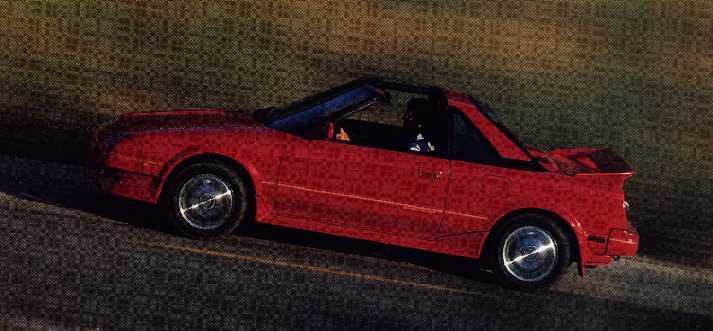
| fuel consumption figure was 23.0 mpg). So what do you get
for your 23.0 mpg and your extra $2200 above the asking price for the normally aspirated
MR2? Power. Lots of it. In supercharged form, the high revving 1.6 liter engine boasts 145
bhp at 6400 rpm and 140 bl-ft of torque at 4000. The result is an instantaneous kick of
acceleration when your right foot goes to work. There is none - repeat: not any - of the
frustrating lag that we have grudgingly come to live with and hate as drivers of
turbocharged engines. The supercharger works directly off the crankshaft, forcing air into
the combustion chamber just off idle, so no time is wasted waiting for the blower to
"spool up". |
This lag-less, torquey acceleration in the Supercharged MR2
represents a second blessing in that the complaint universally uttered about the normally
aspirated MR2 was that feet-of-clay off the line. The supercharged version dynamically
puts this complaint to rest with an abundance of low end torque. Driving the
Supercharged MR2 is a pleasure. Along with the new power, there is the same willing,
affable, neutral handling attitude that we praised so highly when R&T did a long term
test of a 1987 MR2. the steering is quick, precise and nimble. The car pulls heroically in
all gears all the way up to it's 7500 rpm redline, and cruises the highway effortlessly at
70 mph in 5th |
with the tachometer reading a cool 3500 rpm. Near the
limit, the light, little car exhibits very manageable understeer. A tendancy toward drop
throttle oversteer in the Supercharged MR2 has been addressed by the addition of a rear
anti-roll bar in the 1989 model.
In instrumented testing, the Supercharged MR2 turned in an extremely balanced
performance. It's straight line numbers were very livable - 0 to
60 mph in 7.7 seconds, the quarter mile in 16.0 and the handling figures were downright
classy - 63.4 mph through the slalom and a challenging 0.80g on the skidpad. |
Fuel-conscious drivers will want to
keep tach mounted supercharger light off. Fun loving drivers will want it on continuously |
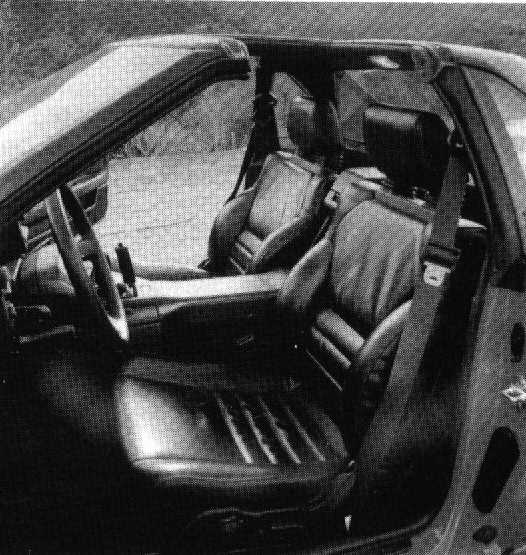
|
If the styling changes between the 1987 and 1988
MR2 models were subtle, the they are imperceptible in the 1989 version. For better or
worse - depending on how your tastes run - this years MR2 looks identical to last year's
MR2. It is offered as a hardtop or T-top with lockable glass panels and snap in inserts.
The trunk space carved out behind the engine is of only minimal use and heats up like an
oven. One nice touch on the 1989 model is the way the center mounted brake light is
integrated into the rear spoiler of the aero equipped MR2s. The interior is still a
comfortable cockpit with seats that feel terrific and are fully adjustable.
The thick, tri-spoke steering wheel is grippy, the gauges familiar and very readable. If
there is a drawback, it's the ventalation system with it's second rate series of recessed
vents. |
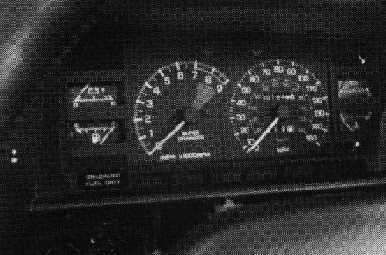
|
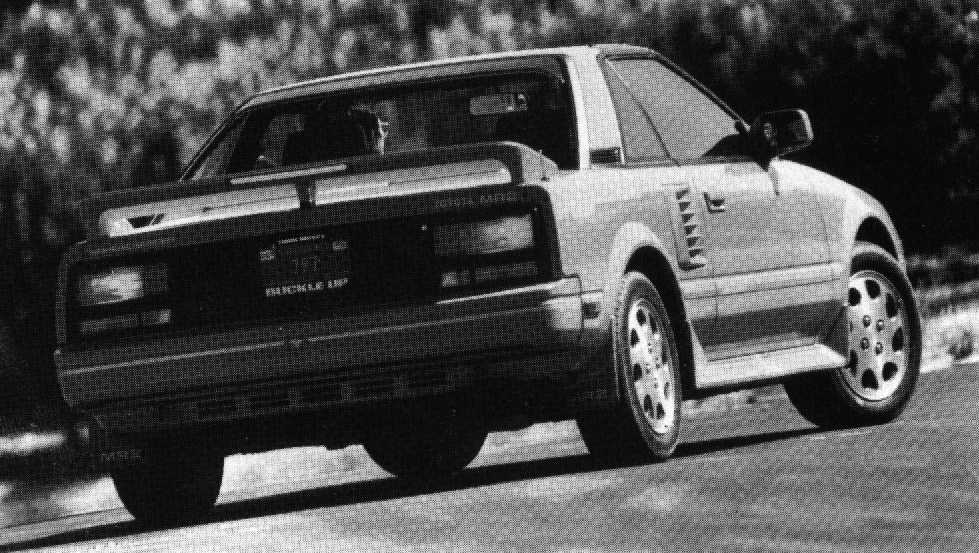 |
Rear view is what most equally priced cars will see in a drag race.
Supercharged sticker on left tells them why.
|
| Again, it depends on your philosophy of cars. Historically, Japanese cars
have been too consistent to elicit much affection from their owners. An enthusiast driver
needs to be needed by his sports car. He needs to be able to throw his arm around the
car's shoulder when the heater fan motor burns out or the 2nd gear synchro starts to go
and say, "Hey, it could've happened to anyone." Only rarely does a Japanese
car need to be forgiven. Thus the cars have to be appreciated, but not necessarily loved
by enthusiasts. The original, affordable MR2 from 1985 (along with it's similarly spirited
countryman from Honda, the CRX Si) changed all that. It was still a dead on consistent
car, of course, but it's makers also installed it with a zeal and eagerness to perform
that couldn't help winning the minds and hearts of U.S. enthusiasts.
In August 1985, Road & Track published a road test in which the 112 bhp/97 lb/ft of
torque MR2 effectively trounced a bevy of imported and domestic 2 seat sports cars. The
seeds of passion were sown. |
In December 1987, those seeds came to fruition as the Supercharged MR2 -
priced at $17,500 - found itself on R&T's "10 Best Cars in the World" list
in both the "By Value" and "By Passion" catagories. But time, tide
and supercharging have taken their toll on the MR2 in one important area: cost. When
Toyota first released its mid-engined bullet four years ago, an inspired and breathless
public could show up at the Toyota dealers front door with $10,999 and drive away in a
brand new MR2. Today, with the Japanese yen beating the American dollar to a pulp, the
Supercharged MR2's price tag is edging toward the "think twice about buying"
threshold of $20,000. That cost, combined with performance car insurance rates that are
fixed somewhere up in the Van Allen belt, add up to a prescription for hard times for MR2
sales, passion nonwithstanding.
Toyota's answer to the problem of what to do with the MR2 in the future is a
provacative one. Due for a change in 1990, it appears as though the next generation MR2 is
headed for a big
|
change. Toyota is reputed to have a 150 mph, $30,000 MR2 online for the
1990 model year. Due for release in Japan early next year, the car will be 8-10 inches
longer, an inch wider and an inch lower. It will probably be powered by a 2.0 liter
engine, with the extra horses and torque supplied by optional turbocharging. performance
is said to be aimed at Porsche 911 and Lotus Turbo Esprit lines. The styling of the new
car will be distinct, yet evolutionary, following that of the current MR2. The
prediction is that Toyota has decided to abandon it's niche in the American entry level 2
seater market to actively pursue the upscale sports car buyers who can afford pricey
performance cars and the equally pricey add ons like liability insurance. It depends on
your philosophy... and your pocketbook.
But for now, at least, there is an inspiring yet affordable 2 seat, mid-engined sports
car that appeals to almost anyones philosophy: the Toyota Supercharged MR2. It's a car
that has earned it's PhD.
-Richard Homan
|
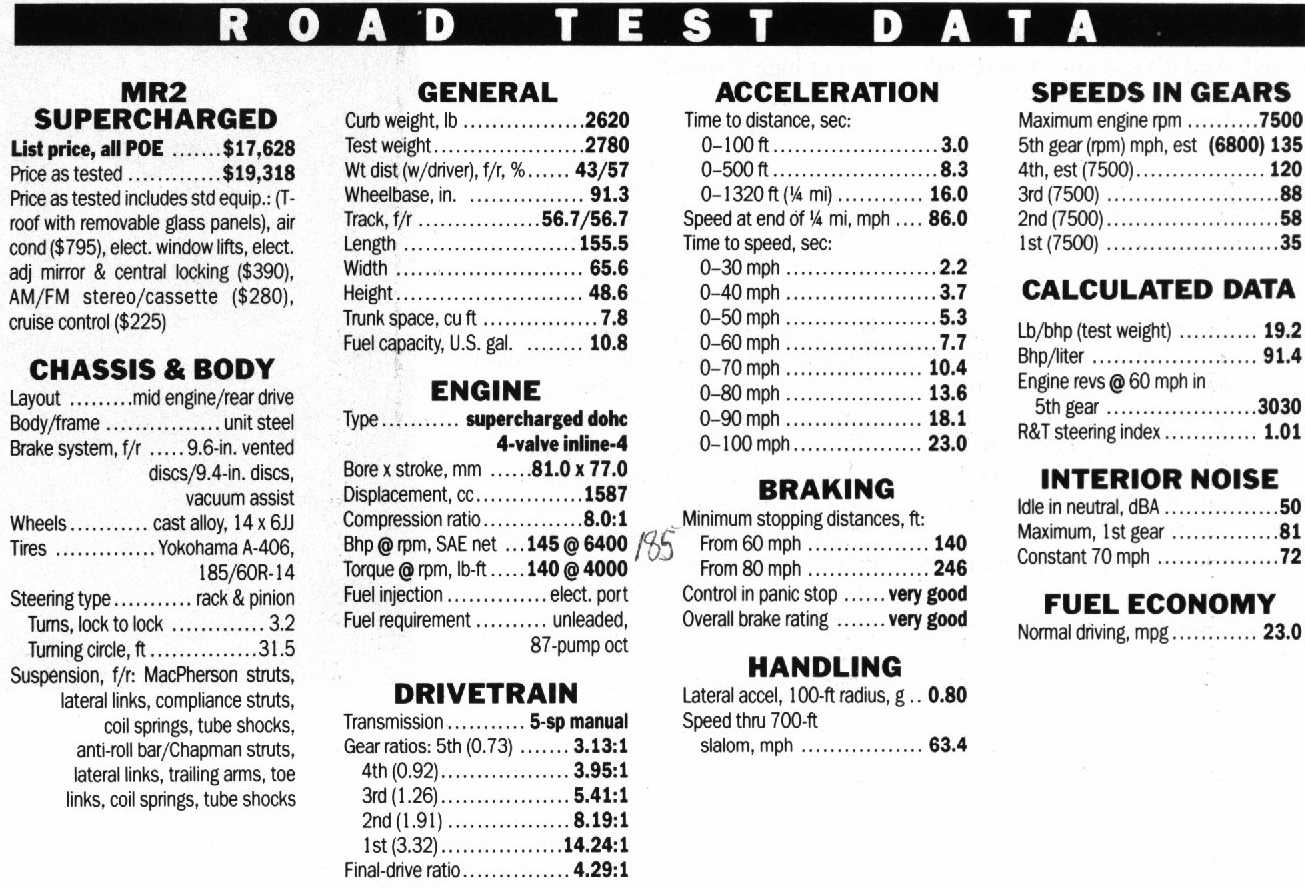
|
![]()